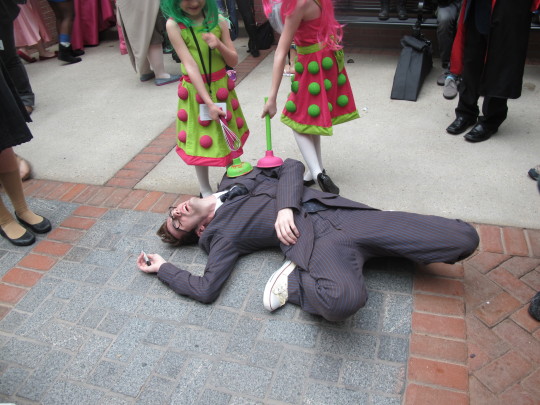Don't wanna be here? Send us removal request.
Text
May 29th
As we moved from the capital to (arguably) the most famous college town in the world, we had just one official item on the itinerary: the Pitt-Rivers.
The Pitt-Rivers is best described in several ways. The first one we really talked about, and what I would call the simpler way, is as "an anthropological museum". It contains nothing purely natural, instead only focusing on the objects that are made by humans. There was a large case of masks, several cases packed with various instruments, the famous shrunken heads, fabrics and baskets and knives and idols. In some way, most any facet of human life was displayed (though I didn't see a case devoted to games, but I may have simply missed it in a tired haze). This anthology is what I would chiefly like to discuss under the idea of an anthropological museum.
According to the official Pitt-Rivers website,
The much-loved Pitt Rivers Museum is unlike any other. Founded in 1884, it houses within an atmospheric building more than 500,000 objects, photographs and manuscripts from all over the world, and from all periods of human existence. Within these are exceptional objects of ritual significance, and objects made for tourists or trade.
The Museum has consciously cultivated its characteristic layout: artefacts are arranged by type into a ‘democracy of things’, rather than by time or region. This reveals fascinating distinctions and parallels across cultures, and encourages questions about the ways in which humanity tackles problems, and creates, understands and embraces life across the world.
This, along with their history page, suggests that the primary distinction and purpose of the museum is to encourage the discovery of convergent lines of thought across cultures, to compare the solutions to the same problems we faced (cutting wood, creating jewelry, writing in a lasting way) as a mode of insight.
(As an aside, a somewhat humorous example in nature is how some whales cope with 'the bends'. Decompression sickness, more commonly known as the bends, is what happens when divers surface too quickly. Under pressure, more gasses can dissolve in the blood, and if one doesn't surface slowly, bubbles can form in the veins as these gasses come out of solution; needless to say a very bad, and sometimes fatal. Human solutions to this involve just waiting at various depths as the gasses are slowly passed out of our systems. Some whales, who as sea mammals need to surface regularly, but also dive to huge depths, cope another way: store the gasses in their bones, which we can see when we find their skeletons and see bubbles in their bones.)
The museum itself is much different than that text would imply, both in form, and the typical visitor's view. The cases, be they wall cases or floor cases, are absolutely stuffed with bits and bobs for everything. One case that was maybe 18"x24" had no less than 15 large opium pipes in it, adjacent to a couple dozen snuff boxes. The cases that had narrow fields of focus (flutes, drums, smoking) were indeed what the text promised, but the broader cases, which were equally as numerous, blurred the objects more than strengthening them with the packing of the shelves.
"Geometric Form in Art" was the subject of several cases. This is a nearly meaningless phrase, and the lack of the very clear didactic material, and the average visitor will just be hit with a cacophony of statuary, pottery and painting that just drowns out any of the distinguishing notes in each object. Without the guided tour, it would have been similarly for me, just looking at the objects, and then taking in generals gists of expression and region, without considering the racist past of the museum itself
4 notes
·
View notes
Photo

Title: On the Origin of Museums
Medium: Watercolor
May 29, 2019
When our various on-site leaders gave their spiels about the museums, the basic founding, and maybe some fun facts, the opening statements all were some variation on “[Insert rich white name] started collecting these objects, and upon his death bequeathed them to the nation for the betterment of the common man”. This stamp of their names and legacies of simply hoarding the objects for just aesthetic qualities is a mark that is not super separable from the institutions themselves, particularly in the cases where the deed of gift specifically forbids any changes to the display and/or composition of the collection. The hoarding of these objects only serves to anonymize the creators in a way that doesn’t speak to anything except the 5-mile view of Art. As someone not trained in art whatsoever, I couldn’t really tell the difference between Michelangelo and Raphael, Monet and Rembrandt, and they are well known masters, much less the artisans of the Benin Bronzes or African Textiles shoved in the basement of the British Museum.
The 4 museums that are represented here, in clockwise fashion, are the British museum, in the form of the enlightenment room, the Soane Museum, characterized by the picture room’s swinging walls and yellow lights, the National Gallery, with the bold colored walls and floor mosaic, and the V&A, particularly the medieval collection with the huge mass of white marble, all overlayed with an anonymous white face.
3 notes
·
View notes
Photo




ain’t no party like a wilfred mott christmas party
31K notes
·
View notes
Photo


The Doctor fights the cutest daleks in the history of the universe and loses to the cuteness
Katsucon 19
52K notes
·
View notes
Photo










“On every world, wherever people are, in the deepest part of the winter, at the exact mid-point, everybody stops and turns and hugs. As if to say, “Well done. Well done, everyone! We’re halfway out of the dark.” Back on Earth we call this Christmas.”
6K notes
·
View notes
Photo









Doctor Who wishes Merry Christmas (and a Happy New Year)
14K notes
·
View notes



